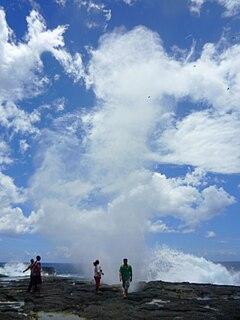
Margaret Mead was an American cultural anthropologist who featured frequently as an author and speaker in the mass media during the 1960s and 1970s. She earned her bachelor's degree at Barnard College in New York City and her M.A. and Ph.D. degrees from Columbia University. Mead served as President of the American Association for the Advancement of Science in 1975.
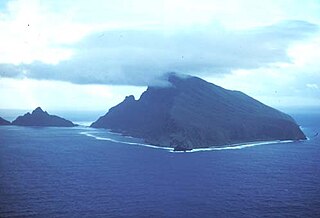
The Samoan Islands are an archipelago covering 3,030 km2 (1,170 sq mi) in the central South Pacific, forming part of Polynesia and the wider region of Oceania. Administratively, the archipelago comprises all of Samoa and most of American Samoa. The two Samoan jurisdictions are separated by 64 km (40 mi) of ocean.

Savaiʻi is the largest and highest island in Samoa and the Samoan Islands chain. The island is the fifth largest in Polynesia, behind the two main islands of New Zealand and the Hawaiian Islands of Hawaii and Maui.

Mulifanua is a village on the north-western tip of the island of Upolu, in Samoa. In the modern era, it is the capital of Aiga-i-le-Tai district. Mulifanua wharf is the main ferry terminal for inter-island vehicle and passenger travel across the Apolima Strait between Upolu and the island of Savai'i.
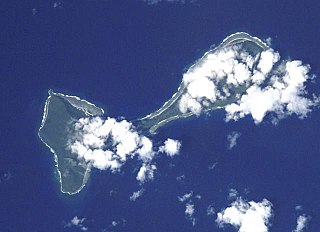
Ofu and Olosega are parts of a volcanic doublet in the Manu‘a Group of the Samoan Islands—part of American Samoa. The twin islands, formed from shield volcanoes, have a combined length of 6 km and an area of 12 square kilometers ; their population is about 500 people. They are geographic volcanic remnants separated by the narrow 137-meter-wide (449-foot) Asaga strait, a natural bridge of shallow coral reef. Before 1970, one had to wade between the two islands at low tide; now a single-lane road bridge over the strait connects villages on Ofu island with those on Olosega.
Gregory Louis Possehl was a Professor Emeritus of Anthropology at the University of Pennsylvania and curator of the Asian Collections at the University of Pennsylvania Museum of Archaeology and Anthropology. He has been involved in excavations of the Indus Valley Civilization in India and Pakistan since 1964, and is an author of many books and articles on the Indus Civilization and related topics. He received his BA in Anthropology from the University of Washington in 1964, his MA in Anthropology from the University of Washington in 1967, and his PhD in Anthropology from the University of Chicago in 1974. He has conducted major excavations in Gujarat, Rajasthan (Gilund), and in January 2007, began an excavation at the UNESCO World Heritage site of Bat in the Sultanate of Oman.

Aiga-i-le-Tai is a district of Samoa which includes the small islands of Manono, Apolima and tiny uninhabited Nu'ulopa lying in the Apolima Strait between the country's two main islands of Upolu and Savai'i.

Tuamasaga is a district of Samoa, with a population of 83,191. The geographic area of Tuamasaga covers the central part of Upolu island.

Roger Curtis Green was an American-born, New Zealand-based archaeologist, Professor Emeritus at The University of Auckland, and member of the National Academy of Sciences and Royal Society of New Zealand. He was awarded the Hector and Marsden Medals and was an Officer of the New Zealand Order of Merit for his contributions to the study of Pacific culture history.

American Samoa is an unincorporated territory of the United States located in the South Pacific Ocean, southeast of Samoa. Its location is centered around 14.2710° S, 170.1322° W. It is on the eastern border of the International Date Line, while independent Samoa is west of it.
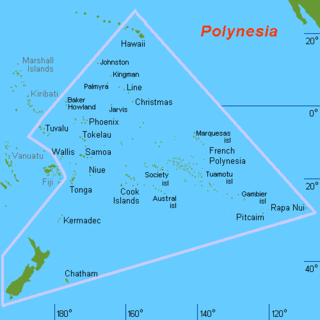
Polynesia is a subregion of Oceania, made up of more than 1,000 islands scattered over the central and southern Pacific Ocean. The indigenous people who inhabit the islands of Polynesia are termed Polynesians, and share many similar traits including language family, culture, and beliefs. Historically, they had a strong tradition of sailing and using stars to navigate at night. The largest country in Polynesia is New Zealand.

Archaeology of Samoa began with the first systematic survey of archaeological remains on Savai'i island by Jack Golson in 1957. Since then, surveys and studies in the rest of Samoa have uncovered major findings of settlements, stone and earth mounds including star mounds, Lapita pottery remains and pre-historic artifacts.
Janet Marjorie Davidson is a New Zealand archaeologist who has carried out extensive field work in the Pacific Islands throughout Polynesia, Micronesia and Melanesia.

Jack Golson is an archaeologist who has done extensive field work in Melanesia, Polynesia and Micronesia.

Vailele is a village situated on the central north coast of Upolu island in Samoa.
Richard N Holmer is a professor of anthropology at Idaho State University. He has conducted extensive archaeological research in Mexico, Samoa, the American Desert West, and Alaska.
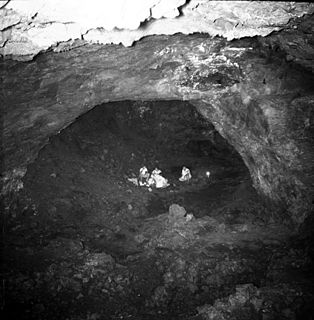
The Falemauga Caves are large natural caverns in a series of lava-tunnels situated in the Tuamasaga district along the central ridge of Upolu island in Samoa. The caves have been studied by archaeologists in Samoa with evidence of human occupation in pre-history. They were also used as a place of refuge by the people of Tuamasaga.



